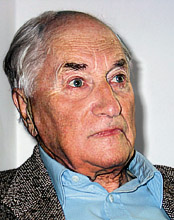Russian Virtual Computer Museum. → Hall of Fame → Boris Moiseevich Kagan
Boris Moiseevich Kagan
Translated and edited by Alexander Nitusov

Professor Boris Moiseevich Kagan (1918 Gomel – 2013 Los Angeles) – famous scientist and engineer-designer in the field of automatics and computer engineering; scientific degree “Doctor of technical sciences”.
In 1941 volunteered to the Red Army (Soviet Army), participated in actions. In 1942 was recalled from army to take part in research and development of technical systems for army needs.
In the same 1942 he was given a state award – the order “Red Banner of Labour”.
In 1949 awarded “Stalin Premium”. Awarded doctorate Honoris Causa.
B.M. Kagan made significant contribution to Soviet space research programs; he actively participated in founding and development of the famous All-Union Scientific Research Institute of Electromechanics (AUSRIE) (Всесоюзный НИИ Электромеханики), he also established and headed the chair “Electronic Computing Machines and Systems” at the Moscow Institute of Transport Engineers[1](technical university).
Boris Kagan was born in 1918 in town of Gomel (Byelorussia), into the family of a barrister Moissey Alexandrovich Kagan, and his wife a dentist Rachel Solomonovna Kagan/Khatsrevina.
His first years Boris lived with the parents and sister in big industrial centre Kharkov (Ukraine), then the family moved to Moscow. In 1941 Boris successfully graduated from the Moscow Power Engineering Institute (founded in 1930, then the biggest and the most modern technical university of the USSR). He received diploma of engineer in “Automatics and Telecontrol”.
Since 1940, still as a student, Boris Kagan was working at the AUSRIE at the laboratory of electrical drives with remote control headed by outstanding scientist Andronik Iosifyan (А.Г. Иосифьян) – future USSR academician, founder and director of the All-Union Scientific Research Institute of Electromechanics (AUSRIE) and its affiliates.
After graduation he continued work under A.G. Iosifjan's supervision; he collaborated with Iosifjan altogether 35 years.
On the 15th of October 1941 (the critical day of the battles on approaches to Moscow) Boris volunteered to army, although he should stay at the institute as a participant of weaponry systems development projects. He was taking part in the legendary “Battle of Moscow” (https://en.wikipedia.org/wiki/Battle_of_Moscow) until the mid-1942, when situation on the Moscow front improved and he was recalled to the institute to resume his work.
Already in November 1942 he was awarded the order “Red Banner of Labour”. In 1946 he defended dissertation and received scientific degree “Candidate of Technical Sciences”.
In 1944–1949 Boris Kagan headed complex research and design works on producing remote control systems for aircraft guns operation (guns on the A.N. Tupolev's “flying fortress” – heavy bomber Tu-4). His task consisted, among others, in implementation of new technological foundations.
In 1949 B.M. Kagan and his colleague N.N. Sheremetyevski (Н.Н. Шереметьевский) were awarded the “Stalin Premium” for successful completion of that work.
In the very beginning of the 1950s B.M. Kagan managed to find unique solution of the precession increasing problem for on-board power supply sources frequency regulators. The problem had principle importance for the general task of increasing precession of ballistic missiles flight trajectories.
Implementation of his solution/invention increased the precession 100 (!!!) times. For this work the USSR Higher Attestation Commission awarded him doctorate (Doctor of Technical Sciences) Honoris Causa, without preparing thesis/defending dissertation.
He was also given state awards for scientific contribution to development of the Soviet Earth satellites, and the spaceship “Vostok” for the flight of Yuri Gagarin.
Since 1953 scientific interests of Dr. B.M. Kagan were mainly focused on problems of electronic digital computers development and implementation in scientific and engineering sphere. It was Boris Kogan who established computer department at the AUSRIE. He personally took part in making one of the first (electron tube) computers and the first semiconductor based control computers.
He also established the chair “Electronic Computing Machines and Systems” at the Moscow Institute of Transport Engineers. That time it was one of the leading educational teams in that field.
B.M. Kagan authored and published numerous scientific monographs and course-books on actual problems of automatics, especially on computers and computing; many of his works were translated into German, English, Chinese and some other languages.
The last years of his life he spent in the USA in suburbs of Los Angeles, where he died in 2013.
References.
1. Earlier it was named F.E. Dzerzhinskiy Moscow Institute of Transport Engineers



